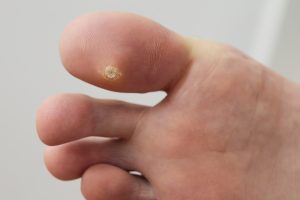Ankle Instability Treatment How do we treat ankle instability? When your ankle is injured, rehabilitation is crucial and starts the moment your treatment begins. Your specialist […]
Verrucae/wart & corn removal
Wart & Verrucas
What is a wart & verruca?
A wart is an infection in the top layer of the skin caused by the HPV virus. They are small growth that can be found on any part of the body. Warts found on the feet are called plantar warts, these are also called verrucas.

Causes of warts & verrucas:
Warts and verrucas are caused by a virus that can be spread to people through contaminated surfaces or direct skin contact. Common areas for this are suspected to be around swimming pools, communal changing rooms and showers.
Plantar warts typically appear on the balls and heel area of the feet, as there area has an increased pressure.
They can can be prevented by not walking barefoot in public places, not sharing towels, socks or shoes. Resisting picking your wart or verruca may help prevent it from spreading.
Symptoms of warts & verrucas:
Warts and verrucae do not always cause symptoms, however, they can become painful, especially if they are under a heavy weight bearing structure. They are a small bumpy growth of hard skin, often with tiny black dots. These can disappear on their own but equally, can spread and increase in size.
Diagnosing a wart & verruca:
Warts and verrucae can be prevented by not walking barefoot in public places, not sharing towels, socks or shoes. Resisting picking your wart or verruca may help prevent it from spreading.
Excision of verrucae and warts
Treatment for plantar wart removal or wart removal can include over-the-counter medication, this usually involves the use of salicylic acid but stubborn painful verrucae may benefit from excision.
The procedure is typically carried out in our central London location, 17 Harley Street, London, W1G 9QH, based near Oxford Circus Station. Surgical removal of the verruca or wart is commonly done by hyfrecation (electrical burning) under local anaesthesia. An injection is carried out to numb the area and the verruca is burned out using hyfrecation. You will need to rest, wear a moderate dressing, and keep the wound clean and dry for at least 48 hours, then change the dressing daily until the wound is dry. This usually takes 2-3 weeks.
Frequently asked questions
Most verrucas will go on their own over a couple of years. You can file down the verruca with a standard file. Removing the hard skin development usually relieves the pain. Be careful when treating them yourself though as they are contagious and you don’t want them to spread. If you file them down, only use the file on the verruca. Once you have filed them down you can use salicylic acid on them as a mild form of treatment. Repeat this daily and file the bulk down every week.
Verrucas are caused by a virus that gets into the skin and produces a painful hard bump. As the virus is contagious you are more likely to get this if you walk barefoot in public areas.
Verrucas are caused by the human papilloma virus (HPV) but are different strains than genital warts.
There are many treatments for verrucas. You can try using salicylic acid as an at-home treatment or see a podiatrist. In a podiatry clinic you could try cryotherapy, needling, electrocautery or excision. Cryotherapy involves spraying bursts of liquid nitrogen on the verruca to freeze it. Needling treatment is when you puncture the verruca multiple times with a needle to make it bleed and stimulate your immune system, this is carried out under local anaesthesia. Electrocautery and excision are also carried out under local anaesthesia. Electrocautery burns the area, and excision cuts the lesion out, sutures are then used.
Related Blogs
Flatfoot Treatments
Flatfoot Treatment Flatfoot Treatment If you experience symptoms with flexible flatfoot, the flexible flatfoot surgeon may recommend non-surgical treatment options. Activity Modifications: Cut down on activities that […]
Morton’s Neuroma Treatment
Morton’s Neuroma Treatment Morton’s Neuroma Treatment How do we treat Morton’s neuroma: Non-surgical Morton’s neuroma treatments: We would aim to resolve the pain caused by Morton’s […]
Hammertoe Correction
Hammertoe Correction Hammertoe Correction Toe Deformity Treatment Toe deformities can cause significant pain and difficulty in wearing shoes comfortably. The toe deformity progresses over time until […]
Bunion Treatment
Bunion Treatment Bunion Treatment Bunion surgery techniques have developed over the past two decades producing procedures that produce consistent and reproducible outcomes. It is not uncommon […]
Gait Analysis & Orthotics
Gait Analysis Podogo utilises video gait analysis with specialist software designed to achieve the most accurate diagnosis of the way we walk and run. The major […]
Flat Feet
Flexible Flat Feet What is flat foot? Flatfoot is often a complex disorder, with diverse symptoms and varying degrees of deformity and disability. There are several […]
Tendon Problems
Achilles Tendon Problems What is the Achilles Tendon? A tendon is a cord of flexible, thick collagen tissues which joins a muscle to a bone. The […]
Heel Pain Syndrome
Heel Pain What is heel pain? Heel pain is a common foot condition, it is usually felt either under the heel or just behind it. The […]
Verrucae/wart & corn removal
Wart & Verrucas What is a wart & verruca? A wart is an infection in the top layer of the skin caused by the HPV virus. […]
Ingrown toe nail removal surgery
Ingrown Toe Nail What is an ingrown toenail? Ingrown toenails are a common condition in which the side of a toenail grows into the skin , […]










